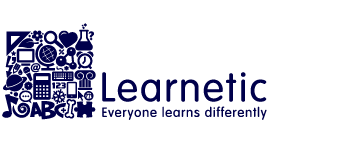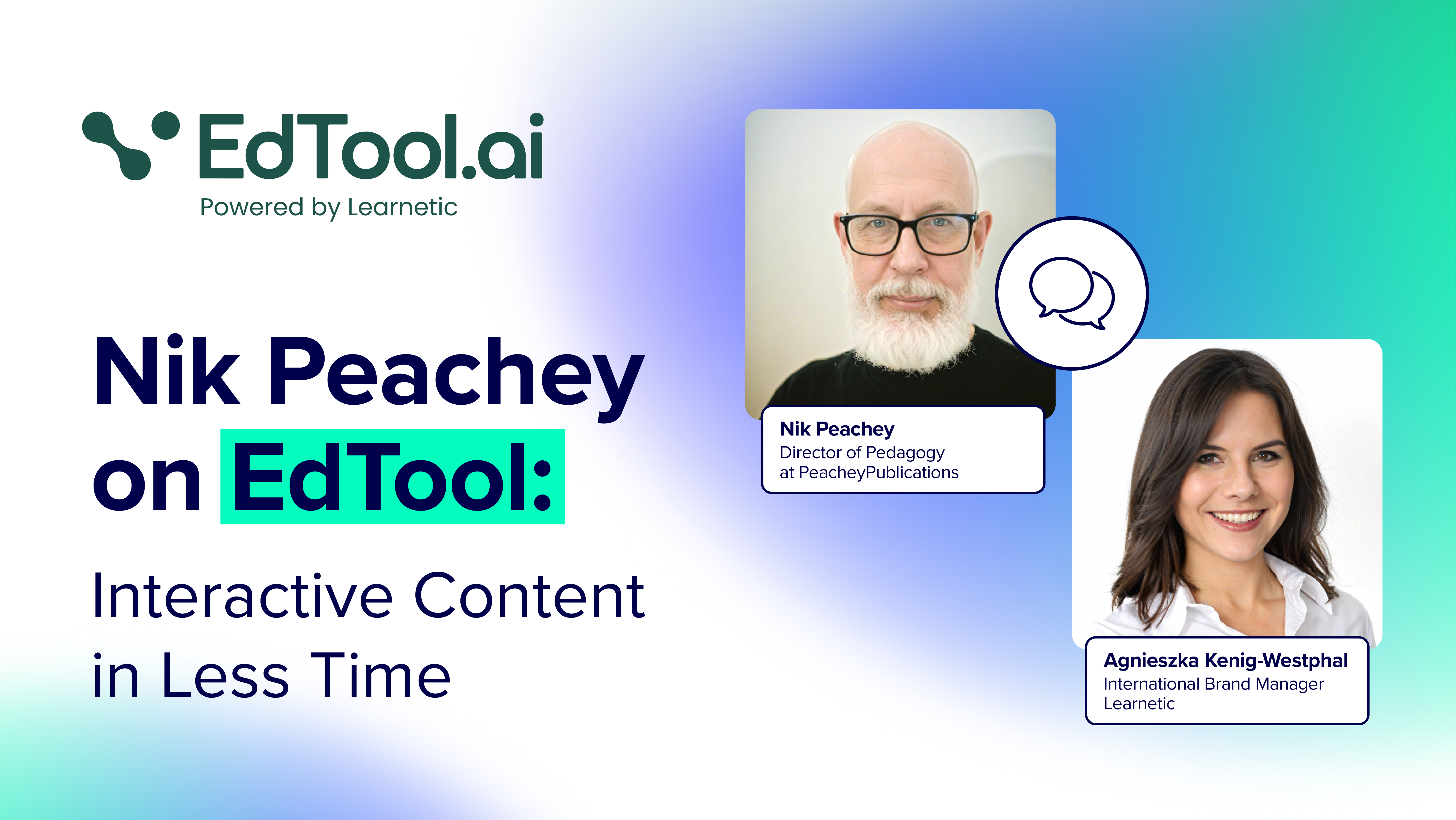EdTool and the Educator: Nik Peachey’s Take on AI-Assisted Content Creation and Sharing Platform
The integration of AI into classrooms is no longer a futuristic concept – it’s already reshaping the way educators teach and students learn. According to a 2024 Forbes Advisor survey, 60% of teachers are now using AI tools in their classrooms. That number alone speaks volumes about the readiness of the education sector to embrace innovation.
Even more encouraging, 55% of those educators say AI has had a positive impact on teaching and learning. These figures paint a clear picture: the demand for intelligent, adaptive tools in education is growing, and the appetite for AI-driven solutions is real.
A separate report by the EdWeek Research Center reinforces this outlook. Nearly, 57% of educators and administrators believe AI use in education will continue to increase.
At Learnetic, we saw this shift coming and that’s what led us to develop EdTool – an AI-assisted platform designed to help educators save time and simplify the content creation, sharing and analysing process. EdTool empowers teachers to craft engaging, high-quality learning materials faster and more efficiently than ever before.
To ensure we were on the right track, we invited Nik Peachey, a respected voice in educational technology, to put EdTool to the test. His insights not only validated our approach but also helped shape the roadmap for its future development.
Now, we’re excited to share Nik’s perspective on using EdTool – his experience, observations, and where he sees the biggest impact for educators like him.
Nik Peachey – with over 30 years of global experience in teaching, training, and educational technology consultancy, Nik has established an international reputation as a leading expert in integrating technology into language education.
Agnieszka Kenig-Westphal, Learnetic: Nik, you’ve explored countless EdTech platforms over the years. How well do you think EdTool responds to the challenges educators face today?
Nik Peachey: One of the biggest challenges educators face today is finding the time and tools to create engaging digital content that works across various teaching contexts – from traditional classrooms to blended and fully online environments. What stood out to me about EdTool is how effectively it tackles that problem.
Unlike many AI tools that just generate static worksheets or lesson plans, EdTool goes a step further by enabling the creation of genuinely interactive learning experiences. That’s especially valuable in device-rich classrooms or for students learning remotely. It helps bridge the “digital use divide” by making high-quality, interactive content accessible across different devices, which is essential for inclusive and flexible teaching.
And with EdTool’s K–12 Content Repository offering thousands of ready-to-use, curriculum-aligned resources, teachers can quickly find and present high-quality materials in the classroom without starting from scratch.
It’s clear that EdTool is built with today’s classroom realities in mind – and it shows real promise in helping teachers streamline content creation without compromising educational value.
Agnieszka Kenig-Westphal, Learnetic: That’s exactly the challenge we hoped to address. For educators working with existing content, how practical is EdTool for updating and transforming older materials into interactive formats?
Nik Peachey: I’ve used a lot of content authoring tools, and creating or updating quality interactive learning content can be incredibly time-consuming. But with EdTool, the combination of AI and pre-structured lesson templates can transform that process. What used to take days now takes minutes.
What’s great is that educators still retain full control – you can author and refine the content however you like. But AI handles the heavy lifting. You can start by uploading text, images, or even taking a photo of a textbook page. There’s also a topic prompt option for quick starts. A mobile app is even on the way, which will make things even smoother.
This would be great for publishers who have out of date materials that they want to refresh and digitise.
Agnieszka Kenig-Westphal, Learnetic: With so many AI-powered content creation tools entering the education space, it can be hard to spot real innovation. From your perspective, what makes EdTool stand out among the growing number of solutions available?
Nik Peachey: What really sets EdTool apart is how thoughtfully it’s been designed with educators’ actual needs in mind. Once you decide on your starting point, you can generate text and then choose the different types of learning or testing interactions you want to build around the content simply by dragging interaction blogs into a sequence on your page. Once you have the sequence of blocks, you can add specifications to the blocks such as how many items in a matching exercise or how many multiple choice questions and then you just click on the AI to generate the actual content for the interactions. The core content doesn’t have to be text and images, you can also add videos and audio.
There is a great variety of interaction types and lots of these are really well suited to language learning, content and language integrated learning (CLIL) or any other type of learning. Another great feature of EdTool is that you can use AI to either translate the rubric to other languages or you can translate the whole of the content to other languages just by choosing the language and clicking.
Once you have created your content you can preview it and see how it looks on a range of different screens, from mobile phone to tablet or laptop. The content works across all these devices. You can also control the appearance of the materials using a predesigned template and make it more like longer web pages or interactive slideshow presentations.
And when teachers need something ready-made, the Content Repository is incredibly useful – it offers thousands of interactive resources across subjects like Math, Biology, Physics, Chemistry, Speech Therapy, and Special Education, all designed to support immediate classroom use.
Agnieszka Kenig-Westphal, Learnetic: At Learnetic, our goal has been to create a tool that not only helps with content creation but also supports teachers and schools in managing the learning process more effectively. What role do you see EdTool playing when it comes to tracking student progress and supporting classroom or whole-school learning management?
Nik Peachey: The slideshow presentation style is great for classroom teaching. You can assign the content to students through the built in learning management system and they can work on the content using their devices. This enables you to track the students progress as they work through the materials. If you are using the platform as a single teacher you can set up classes, access their results and compare them with each other and other classes you teach and find out which students might be falling behind, or which topics whole classes might be struggling with and assign additional or remedial work to them through the platform. This is great for enabling differentiated learning across your classes, especially once you have developed a bank of materials that you can reuse.
What’s particularly helpful is that you’re not limited to your own content. Materials from the Content Repository can also be assigned directly to students. You can create playlists or ready-made assignments from existing resources, making it quicker to support individual learning paths or extend topics covered in class without starting from scratch.
For whole-school use, EdTool is even more effective. Administrators can access all student data over a period of time, compare students and classes across the whole school. This allows them to draw on the school’s materials bank to send additional support materials for those that are struggling or assign more challenging materials for those high performers who are doing well. This capability also significantly helps with writing reports for parents, providing an easily accessible record of student information.
I also really appreciate that all personal data collected through the EdTool platform is securely stored within the European Union on Google Cloud’s infrastructure. It’s reassuring to know that the platform is fully GDPR-compliant, offering strong and transparent data protection for both students and teachers.
Agnieszka Kenig-Westphal, Learnetic: When evaluating EdTech tools, long-term value is a key concern for many educators and institutions. What do you think schools and teachers should look for when choosing a platform that can grow with their needs over time?
Nik Peachey: One important aspect to consider when choosing any tool is to look at how the company sees the future. Buying into any platform involves quite a commitment of time and energy as well as money, so you need to be sure the tool will evolve as the technology evolves and you aren’t going to have to spend more time and money shifting to a different platform in a few years time. After speaking with Learnetic’s experts, it’s clear that you are looking towards the long haul and as well as continuing to develop new types of learning interaction. The Content Repository already gives teachers access to thousands of ready-made lessons across subjects – easy to assign and ready to use. It’s a strong base for supporting individual learning paths, and with AI-driven automation on the way, that process will only get smarter and faster. Exciting times ahead!
Agnieszka Kenig-Westphal, Learnetic: Thank you for your invaluable insights, Nik. We warmly invite all our readers to give EdTool a try.
Access a 90-day Free Trial – Use Code by August 31st
To activate your access, use the code Nik_edtool_90 at: https://www.edtool.com/exclusive-free-trial/
Please note: The code is valid until August 31st. We hope this trial gives you a valuable introduction to the platform.
What’s included?
-
- Full access for you
- 2 extra teacher accounts
- Up to 150 student profiles
- 50,000+ ready-to-use resources – from STEM to Special Education and Speech Therapy
It’s a simple way to see how EdTool can save you time and make content creation easier. Give it a go and see what works for you.





